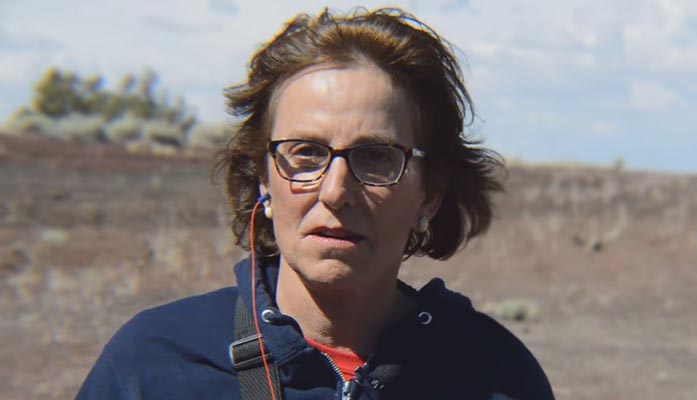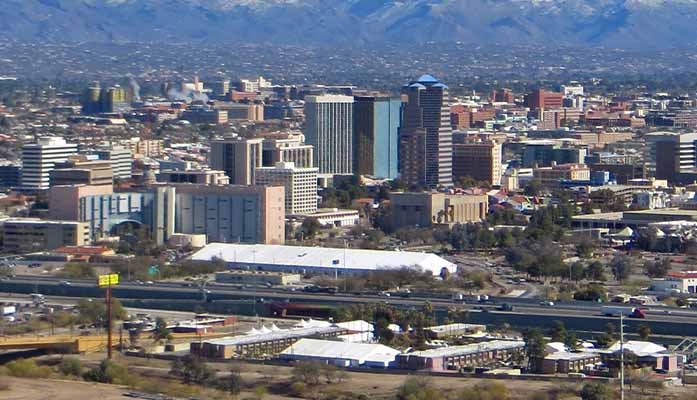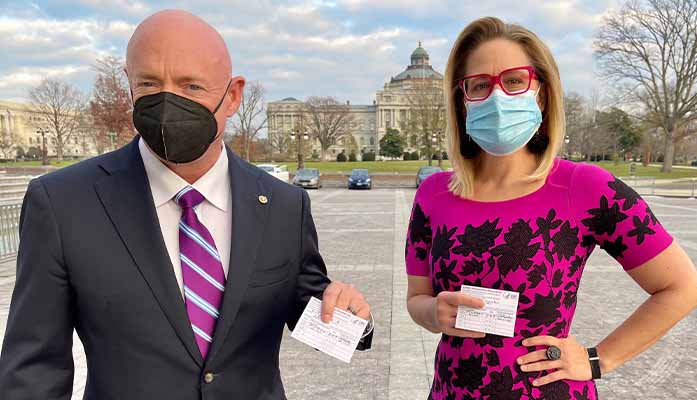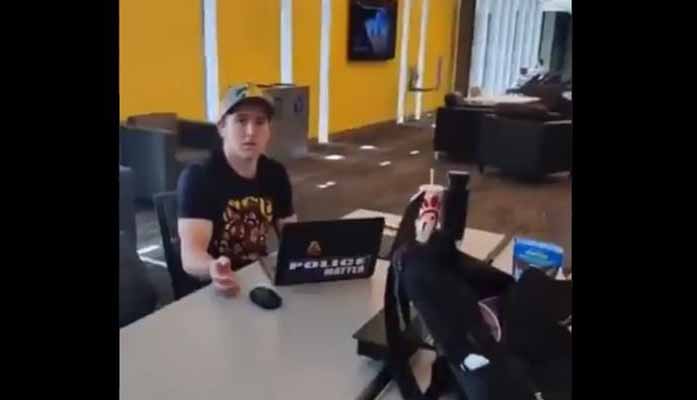
by Terri Jo Neff | Sep 28, 2021 | News
By Terri Jo Neff |
The Arizona Supreme Court will hear arguments Tuesday morning in a first of its kind case about whether a political candidate or campaign committee can be held liable under state law for defaming a third party or a private company while attacking a political opponent.
Pamela Young claims she and her company Models Plus International (doing business as The Young Agency) were defamed and presented in a false light by campaign ads approved by state Sen. Wendy Rogers in 2018. At the time, Rogers was running for U.S. House of Representatives against Steve Smith, a state senator who had worked for Young’s Christian-based modeling company and talent agency for about a decade.
Young alleges Rogers’ campaign utilized radio, telephone, and direct mail ads which gave the impression Young and her company were involved in or condoned sex trafficking of young children. One such ad called Smith “a slimy character whose modeling agency specializes in underage girls and advertises on websites linked to sex trafficking.”
Rogers’ campaign also alleged Smith advertised on the Model Mayhem website, which the campaign described as being “full of pornographic material, which has also been involved in human trafficking.”
Smith lost to Rogers in the 2018 Republican primary by less than seven points, but Rogers lost in the General Election.
Young sued for defamation and invasion of privacy. Rogers has continually argued her 2018 ads never “directly” tied Smith to The Young Agency and never directly linked the company to any illegal conduct.
But the ads did not set well with several prominent Republicans, including Congressman Andy Biggs who called Rogers’ effort “one of the most despicable ads in campaign history.”
In 2019, a Maricopa County judge denied a motion by Rogers and her husband to dismiss Young’s claims. However, the Arizona Court of Appeals reversed the lower court in December 2020, ruling Young had not presented sufficient evidence to move her lawsuit forward against the defendants.
Young filed a petition for review to the Arizona Supreme Court in January seeking for her lawsuit to be reinstated. Rogers’ husband Hal Kunnen and her official campaign committee are also named as defendants.
Arizona Attorney General Mark Brnovich filed an amicus curiae brief in the case in June after which the justices set oral arguments for Sept. 28. A decision against Rogers would reinstate Young’s case, which could have major ramifications in how election advertising is conducted in Arizona and protect the rights of employers whose employees run for public office.
Bill Montgomery, who in 2018 was Maricopa County’s elected county attorney, denounced Rogers’ ads as “the worst kind of politics.” Montgomery was later appointed by Gov. Doug Ducey to the Arizona Supreme Court. He has recused himself from hearing Rogers’ petition. In his place, Judge Philip Espinosa of the Arizona Court of Appeals will sit in on arguments.
The ads also did not set well with Kathleen Winn, who is a member of the Maricopa County Community College District board. She is also an expert on child sex trafficking in Arizona.
“If you happen to believe one of your opponents is exploiting children, trafficking minors, selling them on a website for sex producing a political attack ad is NOT your first course of business,” Winn said. “Contacting law enforcement to report the alleged crime is what you need to do.”
Rogers was elected to the state Senate for LD6 in November 2020.

by Corinne Murdock | Sep 27, 2021 | News
By Corinne Murdock |
Over the past week, Tucson has begun to receive a number of Haitians transported from the Texas border. It is unclear how many Haitians will be brought in; AZ Free News requested those numbers from the Department of Homeland Security (DHS), Pima County, and the various organizations that assist refugees under the Arizona Refugee Resettlement Program. In various reports, Tucson City Councilmember Steve Kozachik indicated that the numbers were large.
AZ Free News also inquired about the vetting procedures for these refugees, if any, and how the government was determining who qualified for refugee status. The entities we questioned either didn’t respond to any of our inquiries by press time or said they couldn’t offer information to the press.
The Biden Administration is resettling Haitians after determining that their number has become a burden to border patrol in Texas. Over 15,000 were estimated to be under a bridge in Del Rio, Texas as of the past week. Tucson officials claim their intake of Haitians is temporary – one to two days, at most according to Kozachik.
The Haitian refugees are either being bussed or flown into Tucson. Once there, they are processed by immigration services and either taken to hotels or Casa Alitas, a shelter run by Catholic Community Services (CCS). Within several days, officials will contact the alien’s next-of-kin or sponsor.
CCS and Casa Alitas told AZ Free News that they aren’t answering press inquiries at this time. We also attempted to contact Pima County – they own the building where CCS operates Casa Alitas. They didn’t respond by press time.
The refugee arrivals report from the Arizona Refugee Resettlement Program didn’t document any Haitian refugees, per its updated numbers last Thursday.
Congressman Paul Gosar (R-AZ-04) questioned how these Haitians were reaching American soil. He noted that Haitians weren’t just coming into Texas – they’d been coming into Yuma as far back as May. Haiti to Arizona is a journey of nearly 2,800 miles.
“Many Haitians are crossing into Yuma as well. In [sic] met dozens in May 2021. All well fed. Clean,” wrote Gosar. “They did not “journey” to our border by foot. They were flown. Who is paying?
https://twitter.com/DrPaulGosar/status/1440802471522144263
Rather than addressing the crisis-level surge of illegal immigrants at the border, leaving Haitians to crowd together as squatters under a bridge with minimal resources, Vice President Kamala Harris focused her concern on the allegations of poor treatment of the Haitians. She said she was “outraged” by claims that border patrol agents on horseback were whipping the Haitians. The vice president called it “horrible” and claimed it resembled slavery. She said there should be “consequences and accountability” for the border patrol agents.
“And as we all know, it also evoked images of some of the worst moments of our history, where that kind of behavior has been used against the indigenous people of our country, has been used against African-Americans during times of slavery,” stated Harris.
https://www.youtube.com/watch?v=71lOzx6mWqE
The National Border Patrol Council, among many others, debunked claims that border patrol were whipping illegal immigrants. They shared a corrective post from the Border Patrol Horse Patrol.
“Those are split reins; not whips, they are 6 feet long. They are split for when we go into the brush. If we go through thick brush and a tree branch gets caught, it will just slip right through. The reins are connected to the bit. The bit is in their mouth and the last thing we want to do is hurt our partners by tearing up their mouths,” read the post. “You have seen the video of the agent spinning the rein when illegals get close to the horse. It’s to create distance between the horse and the person on the ground. Our horses easily weigh 1200 pounds, they can step on someone and break a bone or kill a small child [if] a person gets too close. We also spin them if someone attempts to grab the reins because the last thing you want is someone who doesn’t know a thing about horses, to have control of the horse you are on. (If an illegal attempts to gain control of our reins it is considered deadly.) The horse can freak out, jump up and roll with you on them. Us as riders can be killed if a horse lands on us. Hope this helps those who have never seen a horse or split reins before… we will continue to support our brothers and sisters in Del Río.”
https://www.facebook.com/bpunion/photos/a.114664391886455/4751246794894835/
Even the photographer who captured the viral images of border patrol holding reins near the Haitians clarified that no agents were “whipping” the illegal immigrants.
Regardless of the fact that these claims were false, the Biden Administration immediately ordered border patrol to cease using horses while handling the border crisis. President Joe Biden even threatened that law enforcement “would pay” for doing their job.
Horses are advantageous in patrolling the border due to their stature and ability to traverse rough, uneven terrain, and due to the animals’ natural gifts: their herding instinct for guiding and corralling illegal immigrants, and their heightened sense of sight and hearing for scoping out illegal immigrants.
Harris was designated to handle the border by Biden at the outbreak of his border crisis earlier this year.
Members of the Biden Administration are also displeased with the Haiti mix to the border crisis – but for different reasons, apparently. Biden’s Special Envoy for Haiti, Daniel Foote, resigned on Wednesday. He claimed that the Biden Administration had ignored or dismissed his recommendations for handling the issues in Haiti that led to the border crisis. Foote said that the forced deportation of thousands of Haitians wasn’t proper protocol, and that the Haitians would suffer or die because of it.
Foote indicated that the Biden Administration’s forthcoming decision to install their pick of leadership for the Haitians would only result in failure again.
“[W]hat our Haitian friends really want, and need, is the opportunity to chart their own course, without international puppeteering and favored candidates but with genuine support for that course. I do not believe that Haiti can enjoy stability until her citizens have the dignity of truly choosing their own leaders fairly and acceptably,” wrote Foote. “Last week, the U.S. and other embassies in Port-au-Prince issued another public statement of support for the unelected, de facto Prime Minister Dr. Ariel Henry as interim leader of Haiti, and have continued to tout his ‘political agreement’ over another broader, earlier accord shepherded by civil society. The hubris that makes us believe we should pick the winner – again – is impressive. This cycle of international political interventions in Haiti has consistently produced catastrophic results. More negative impacts to Haiti will have calamitous consequences not only in Haiti, but in the U.S. and our neighbors in the hemisphere.”
By federal law, refugees are those unable or unwilling to return to their native country due to “well-founded fear of persecution on account of race, religion, nationality, membership in a particular social group or political opinion.”
Haiti is currently facing political turmoil. In July their president, Jovenel Moise, was assassinated by gunmen claiming to be U.S. Drug Enforcement Administration (DEA) agents. His murder incited more chaos in Haiti, on top of the over 90 gangs that hold much of the power in the country.
Then last month, the country was hit with an earthquake, causing 2,200 deaths, an estimated 12,000 injuries, and damaging or destroying around 12,000 homes.
Nearly 28,000 Haitians have been intercepted at the border this year.
Corinne Murdock is a reporter for AZ Free News. Follow her latest on Twitter, or email tips to corinne@azfreenews.com.

by Corinne Murdock | Sep 25, 2021 | News
By Corinne Murdock |
Democratic Senators Mark Kelly and Kyrsten Sinema will likely support the Biden Administration and Democrats’ $3.5 trillion tax plan, causing Americans to pay more in corporate taxes in Arizona than in China. The bill was derived from President Joe Biden’s Build Back Better Plan, and it would be the largest spending bill in American history.
If the bill passes, the federal-state corporate tax rate in Arizona would jump to over 30 percent, while China’s tax rate would be around 25 percent. That’s not including those enterprises in certain industries supported heavily by the Chinese Communist Party (CCP), which could receive a tax rate as low as 10 to 15 percent. Additionally, the bill would cause capital gains tax in Arizona to rise up over 35 percent, while China’s would ring in around 20 percent. This data was compiled by Americans for Tax Reform.
Back in July, Sinema expressed lack of support for the bill in July over its price tag, but not its content. At that point, Kelly hadn’t made a commitment to the bill either.
“I have also made clear that while I will support beginning this process, I do not support a bill that costs $3.5 trillion,” said Sinema. “And in the coming months, I will work in good faith to develop this legislation with my colleagues and the administration to strengthen Arizona’s economy and help Arizona’s everyday families get ahead.”
However, both Sinema and Kelly voted in favor of the framework for the $3.5 trillion plan last month.
The Biden Administration and Democratic Party’s proposed tax increases would cause the U.S. to have one of the highest capital gains taxes in the world.
Analysts with the Tax Foundation estimated that the impact of this policy would reduce the GDP by about one percent: more than $2 for every $1 in new tax revenue, or about $332 billion of lost output annually. Over the course of a decade, the cumulative GDP would reduce by nearly $1.2 to $1.8 trillion, which they stated would far exceed the amount of revenue the plan would raise in the same amount of time.
All while eliminating an estimated 303,000 full-time jobs. The primary cause for these projected negative changes comes from the proposed corporate tax rate. They estimate that this alone would reduce the GDP by .6 percent and eliminate 107,000 jobs.
As for after-tax incomes, they estimated that individual taxpayers would see an average reduction of $800 each year.
The Tax Foundation’s Senior Policy Analyst, Garrett Watson, assessed that ultimately, low- and middle-income families would feel these repercussions the most.
“The economic harm caused by the tax increases would claw back some of the plan’s expanded tax credits aimed at low- and middle-income families. For those in the bottom 30 percent, it would reduce the average net benefit of the plan per filer from $341 to $233, a 30 percent reduction,” wrote Watson. “Before accounting for economic effects, filers in the middle quintile would see a decrease in average after-tax income of about $38 – mostly due to the corporate tax increases – but that would rise to a $493 drop in average after-tax income every year when including the negative economic effects. The top quintile would see a $1,287 drop in average after-tax income, rising to a $3,861 drop in average after-tax income on a dynamic basis.”
They also noted that these proposed changes would raise a net federal revenue of around $1.1 trillion from next year to 2031, without accounting for dynamic factors like the estimated reduction in economy size. However, that revenue would be reduced by $1 trillion in tax credits. If dynamic factors weren’t excluded, federal revenue would ring in around $804 billion in revenue net of tax credits.
Per a poll released by Navigator Research earlier this week, House Speaker Nancy Pelosi claimed that an overwhelming majority of Americans supported the Build Back Better Act. The results meted out to 66 percent of Americans, 61 percent of independents, and 39 percent of Republicans.
Corinne Murdock is a reporter for AZ Free News. Follow her latest on Twitter, or email tips to corinne@azfreenews.com.

by Corinne Murdock | Sep 25, 2021 | News
By Corinne Murdock |
Members of the Multicultural Solidarity Coalition (MSC), a student-led activist group that’s been advocating for the establishment of a multicultural center at Arizona State University (ASU), targeted and harassed two students on video for being white males in a room they’d established as their “multicultural center.” The room in question was the ASU Tempe Campus’s Student Success Center in the Student Pavilion, room 321. It has not officially been designated as a multicultural center – ASU says that efforts for such a center are underway, but the university hasn’t indicated where or when the center will be established. MSC posted the eight minute video of them harassing the two white male students with the caption “Defending the Space” on Instagram. It has since been removed.
The MSC members took offense to the two white male students for their race, sex, and display of conservative-leaning political messages. One of the students had a “Police Lives Matter” sticker on their laptop, while the other wore a “Did Not Vote for Biden” shirt. MSC members told the two students to leave the room and “shut the f*** up” repeatedly, said that they were promoting murderers and white supremacy by supporting police, called them “Karens” for being upset, and ridiculed them for insinuating that diversity or multiculturalism included white people. Out of all the other students in the room, only one individual spoke out in defense of the two white male students: an Asian male student.
The two most outspoken MSC members in the video were an ASU undergraduate student named Mastaani Qureshi and an ASU graduate student named Zarra Teacola. Qureshi is a member of Omega Phi Alpha (OPA), a national service sorority, and enrolled in ASU’s honors college, Barrett. In addition to being MSC’s founder, Teacola is the co-minister of activism for Black Lives Matter (BLM) Phoenix Metro and a PhD Candidate in ASU’s School of Sustainability. Teacola was arrested last October with seven other BLM protestors; they were indicted for charges related to rioting, aggravated assault, obstructing roads, and street gang involvement.
We attempted to contact MSC for comment. They didn’t respond by press time.
According to Teacola, ASU has been complicit with MSC’s claim of the public space to segregate or discriminate against individuals based on their race or creed, especially “white, cis[gender] males.” According to Teacola, ASU President Michael Crow recently gave them the space to use as a multicultural center. Teacola explained that the BLM movements following George Floyd’s death last year caused Crow to change his mind – he’d originally been hesitant to give them a space that excluded certain students based on skin color or gender. No official press release or notice has been issued to reflect this purported agreement for a multicultural center.
“Michael Crow told us that a multicultural center wasn’t inclusive toward white cis males, you know, that’s what he said in 2019. Then come the uprising, the tone really changed, right? And they’re like ‘Okay, okay, you can have your center,’ right?” said Teacola.
It appears that ASU is complicit in MSC’s newly-established authority over this room. ASU told AZ Free News that the incident was a “disagreement” highlighting “differences of opinion” that were “part of the university experience.”
“The Dean of Students Office is aware of the disagreement between a handful of students that was captured in a video circulated on social media. The Dean of Students Office will be discussing it with all involved,” stated an ASU spokesperson. “ASU is a community of more than 100,000 people from all 50 states and more than 150 countries. Differences of opinion are part of the university experience. The university expects respectful dialogue between students in all engagements.”
The university later posted the statement on their website. It is unclear who, if any, will face disciplinary action.
Late Friday afternoon, MSC removed the video of their members harassing the two students. In its place, they issued a statement blaming ASU for not adequately preparing the room for their multicultural space so that the confrontation would’ve been avoided.
MSC defined “inclusion” as securing areas for marginalized people, and “blue lives matter” as a threat to black individuals. Though MSC didn’t use the term “hate speech,” they indicated that certain speech they believed to be wrong was prohibited in their multicultural center. They said that the death threats they received following the video were indicative of pervasive systemic racism and white supremacy.
MSC included links for clarity on their position: “Why People of Color Need Spaces Without White People” a publication from the city of Cambridge, Massachusetts; a Los Angeles Times opinion piece titled “We Need to Talk About Racism and ‘Blue Lives Matter’”; “The Myth of Reverse Racism” from Canada’s Alberta Civil Liberties Research Centre; and a USA Today article titled “What is Systemic Racism? Here is What it Means and How You Can Help Dismantle It.”
Read the statement below:
The Multicultural Solidarity Coalition (MSC) is a group of graduate and undergraduate students from marginalized and oppressed communities who have been trying to create a space for our community members to exist on campus without the ubiquitous threat of racial and gender-based violence that we experience on campus. We have been working toward this goal since 2016 and, as of 2020, we have been coordinating with ASU administrators to establish a multicultural center. The multicultural center is currently housed in one room on campus that was opened this semester and has not yet been fully launched. You can read our full proposal here.
The incident that took place on Thursday, September 23rd is a result of ASU not taking seriously our safety concerns, especially in regards to the multicultural center. Despite repeatedly expressing our concerns during biweekly meetings with Dean Aska last semester, administrators did not adequately prepare the multicultural center before the start of this semester to avoid these types of confrontations.
We believe that inclusion means making spaces safer for the most marginalized students. We understand “blue lives matter” to be an explicit rejection of the Black Lives Matter movement and therefore an overt threat to Black lives. In the new multicultural centers, we will not tolerate people entering with racist slogans to intimidate and antagonize historically and currently marginalized students.
Inclusion does not mean we accommodate white supremacists, their slogans, and behaviors at the cost of endangering all other community members. This has been made overwhelmingly clear by the many death threats we have received. These racially-charged threats are directed at the two MSC members from BIPOC communities who confronted the two white men with a “Police lives matter” sticker and a “Did Not Vote For Biden” shirt who were in the multicultural center making students uncomfortable.
If you do not understand the purpose of a multicultural center, click here.
If you do not understand why “blue lives matter” is racist, click here.
If you do not understand that reverse racism doesn’t exist, click here.
If you do not understand what racism is, click here.
The Multicultural Solidarity Coalition will keep advocating for students from marginalized communities until we have fully-supported and fully-staffed multicultural centers on every ASU campus and we call on students to join us in defending these spaces and to #defendMSC.
(emphasis added, original links maintained)
Read the entire transcript of the incident below, or watch the verbal altercation here. “MALE 1” is the student with the “Police Lives Matter” sticker. “MALE 2” is the student with the black t-shirt reading, “Did Not Vote For Biden.”
MALE 1: What did I do wrong?
TEACOLA: You’re offensive. Police lives matter?
MALE 1: You have the same sticker …?
MALE 2: We’re just trying to do school.
TEACOLA: What?
MALE 1: You have the same sticker as the other –
TEACOLA: But this is our space.
MALE 2: We’ve got a ‘Police Lives Matter’ sticker and we’re getting kicked out, can’t do school.
UNKNOWN MALE IN BACKGROUND: Nobody’s kicking you out.
MALE 2: You just said we have to leave!
QURESHI: No, I said –
TEACOLA: You’re making this space feel uncomfortable.
MALE 2: You’re making me feel uncomfortable.
TEACOLA: But you’re white! Do you understand what a multicultural space [is]? It means you’re not being centered.
MALE 2: White’s not a culture?
TEACOLA: No, it’s not a culture! White is not a culture! Say it again to the camera! You think this is a culture?
MALE 2: This is insane.
TEACOLA: So anyway, this is the violence that ASU does and this is the type of people that they protect, okay? This white man thinks that he can take up our space. This is why we need a multicultural space, because they think that they can get away with this s***.
MALE 2: I’m going to sit here the whole time and you can find somebody to care.
TEACOLA: That’s cool. We will.
QURESHI: We’re not kicking you out. We’re asking you to leave. If you have any consideration for people of color and our marginalization.
TEACOLA: They clearly don’t.
MALE 1: Is there anywhere I can go?
TEACOLA: Yeah! The whole rest of the campus! The second floor, the first floor, the whole MU – every single part of the campus centers you! This is the only space that you’re not centered and you’re still trying to center yourself which is peak cis-white-male bulls***!
MALE 1: I’m not racist, I’m just studying.
TEACOLA: You are racist! Your sticker is racist because police, that’s a job! You can choose to be police. I don’t choose to be black! Okay, no – you can choose to be a cop, you can choose to kill people with a badge, and you’re protecting that s*** which means that you’re racist!
MALE 1: I’m sorry. I wasn’t trying to offend you guys or anything –
QURESHI: I know, I know, but this offends us automatically because these people kill people like me and like us, right? So you’re promoting our murderers. So please just don’t do that.
UNKNOWN MALE IN FOREGROUND: Why is that sticker affecting you negatively? They’re just trying to do their work.
MALE 2: Thank you! Thank you!
UNKNOWN MALE IN FOREGROUND: So, why should that bother you?
TEACOLA: Because! Do you understand that police lives matter was in response to black lives matter?
MALE 1: I pay the same f****** tuition as you!
QURESHI: But you get more advantages.
MALE 1: I don’t! I’m working 60 hours a week while going to school because my parents don’t just give me money.
TEACOLA: Okay! Doesn’t matter! You have the second floor!
MALE 1: You guys are f****** bulls****. F*** you – I don’t care about what color your skin is!
UNKNOWN FEMALE IN BACKGROUND: You can get out of here if you’re going to be yelling at people because –
[overlapping voices]
QURESHI: We make this f****** space! We had to work for five years to make this space.
UNKNOWN FEMALE IN BACKGROUND: Guess what we did? We worked for five years for ASU to build a multicultural space. […] ‘Police Lives Matter’ is saying white supremacist narratives –
MALE 2: We’re not white supremacists!
UNKNOWN FEMALE IN BACKGROUND: ‘Police Lives Matter’ is –
MALE 2: That’s not a white supremacist saying!
TEACOLA: Yes, yes it is. It’s affiliated with white nationalists.
UNKNOWN MALE IN FOREGROUND: They’re just sitting here studying and you guys went out of your way to inconvenience them.
TEACOLA & 2 UNANIMOUSLY: Yes, yes we did because it’s our space.
TEACOLA: We fought for this s*** for five years, since 2016. You have no idea about the labor that was created to create this space –
[overlapping voices]
TEACOLA: No, no we can’t. You’re violent, dude. […] F*** America bro. America was created on genocide and slavery. Look at his face.
[overlapping voices]
UNKNOWN FEMALE IN BACKGROUND: That is the point.
UNKNOWN MALE IN FOREGROUND: They were studying.
[overlapping voices]
TEACOLA: The point is that studying – this is not a space for studying. This is a space for multiculturalism.
[overlapping voices]
MALE 2: I thought we weren’t yelling anymore. You guys were going to kick us out for yelling?
QURESHI: Shut the f*** up.
[overlapping voices]
MALE 1: This is crazy to me… You guys are the racists. You’re the racists.
UNKNOWN FEMALE IN BACKGROUND: [indecipherable] You’re making people uncomfortable. You can go.
MALE 1: F*** you. I was just studying, I pay the same f****** tuition as you.
UNKNOWN FEMALE IN BACKGROUND: This is this white man telling black people ‘f*** you.’
MALE 1: Did you even buy this building?
UNKNOWN FEMALE IN BACKGROUND: Cussing out black people, way to prove yourself.
QURESHI: I work! [indecipherable]
MALE 2: I don’t care where you work!
QURESHI: I told you to shut the f*** up because you’re making me feel unsafe and you’re in my space!
TEACOLA: White people – there’s no such thing as reverse racism, so have fun saying that we’re the racists because there’s no such thing.
[overlapping voices]
TEACOLA: No, we’re not saying white people have to leave.
MALE 1: I’m going to the dean’s office. Come on.
TEACOLA: Go ahead. Go to the dean’s office. Go ahead. You can learn about this s***. You can learn about the history. Go ahead, Karen.
UNKNOWN MALE IN BACKGROUND: The big black people scared me out!
UNKNOWN FEMALE BACKGROUND: No, we didn’t.
MALE 2: You bullied us out, but…
UNKNOWN FEMALE IN BACKGROUND: No, we didn’t. You caused a scene. You caused a scene.
UNKNOWN MALE IN BACKGROUND: You are unaware of history, and it’s ridiculous.
MALE 2: I’m unaware of history? I probably have a further degree than any of you in here.
TEACOLA: So, anyways, we’re here. We had to protect the space because ASU wasn’t. And you know we fought for this space. It was years of organizing, and we’re not going to just let some white supremacists change that.
MALE 2: Oh, I’m going to.
TEACOLA: That’s why we’re here – yeah they’re going to make a scene and go talk to their Karens. But you know, it’s important to recognize why we have to do that and what a multicultural space means because multiculturalism doesn’t mean that, oh, we all come together and hold hands. It means that you provide space and you protect the most marginalized. And s*** like that makes this space uncomfortable.
QURESHI: He threatened us that he will go to the dean. We will see what he has to say to the dean and we will see how the dean reacts. And now we will see who ASU prioritizes in this – students of color and our only f****** room on campus, or white cis men who are threatening black students by saying police lives matter.
MALE 2: Uh, you’re speaking to nobody.
QURESHI: That doesn’t matter. Can you leave?
MALE 2: No.
QURESHI: Okay, you don’t want to leave? That’s fine.
MALE 2: Perfect. I’m not.
UNKNOWN FEMALE IN BACKGROUND: We’re saying to you: this is a multicultural space, you’re making us uncomfortable, and you’re saying you don’t wanna go.
[indecipherable]
QURESHI: You’re not a minority person.
UNKNOWN MALE IN BACKGROUND: What’s your culture, bro?
TEACOLA: Yeah, tell us about your culture. What’s white culture? Stealing things from people? Colonization, co-optation, theft, occupation?
MALE 2: America is like one of the most un-racist countries –
TEACOLA: Whaaa…! He just said America is one of the most un-racist countries. And this is what we mean about who we are you centering, who are you centering?
MALE 2: [indecipherable] … black people in the times of racism.
QURESHI: Don’t speak my truth –
TEACOLA: Well, you don’t even –
MALE 2: There’s no difference in what you do. Bullying me leaving this place [is no different] than what happened in the times of racism.
UNKNOWN FEMALE IN BACKGROUND: We didn’t bully you! We asked you to leave.
MALE 2: You guys – I can’t even do my school. You came over here and said that I’m offending you.
QURESHI: Bro, you can do your schoolwork anywhere in the building. Just not here.
TEACOLA: Anyways, another day of trying to defend this space.
MALE 2: If it makes you feel better about making your group less diverse – it doesn’t make any sense.
UNKNOWN FEMALE IN BACKGROUND: Oh wow, so diversity’s now about including more white people.
TEACOLA: Diversity’s now about including white men!
UNKNOWN FEMALE IN BACKGROUND: You have the whole campus, honey. You have the whole campus.
MALE 2: Angry –
(emphasis added)
Corinne Murdock is a reporter for AZ Free News. Follow her latest on Twitter, or email tips to corinne@azfreenews.com.






